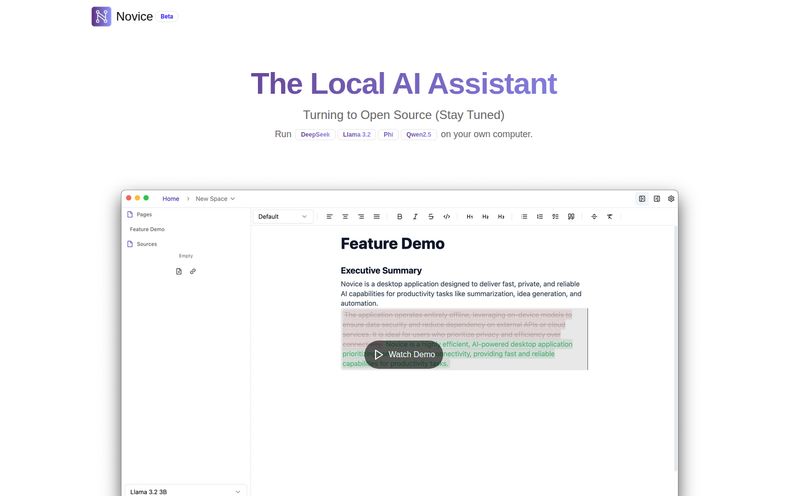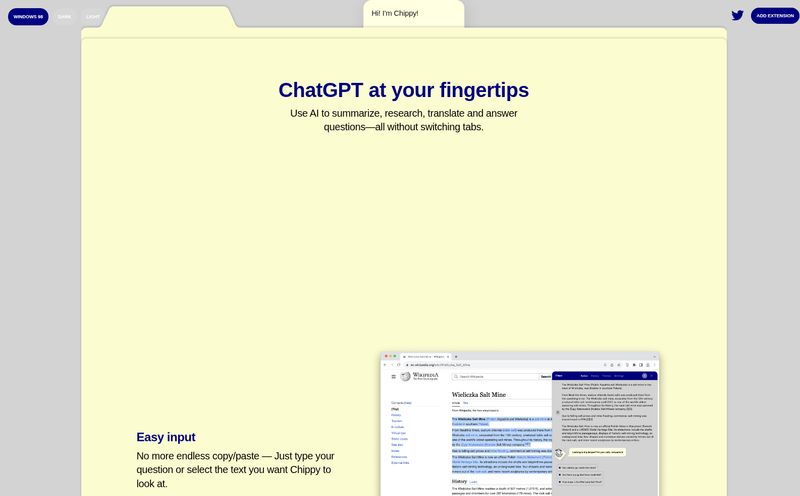We've all been there. It's late, you're deep in the creative zone, and your project is humming along. Your video edit is crisp, your game's animation is smooth, but you're missing something. That one, perfect sound. You know the one. Not just any footstep, but the sound of a leather boot stepping on a single, dry leaf on a crisp autumn afternoon. Not just any door creak, but the groan of a heavy oak door in an abandoned castle.
The hunt begins. You dive into the rabbit hole of royalty-free sound libraries, sifting through thousands of files named `sfx_door_creak_04_final_mastered.wav`. An hour later, you're either settling for something that’s “good enough” or you've given up entirely. It’s a frustrating dance, and one I've danced more times than I care to admit.
So when I stumbled upon a tool called GenSFX, which claims to be a “Free AI Sound Effect Generator” that turns text into sound, my interest was definitely piqued. A free tool that creates custom SFX from a simple description? No sign-up required? It sounded a little too good to be true. Naturally, I had to take it for a spin.
So What Is This GenSFX Thing, Anyway?
At its core, GenSFX is exactly what it says on the tin. It's a web-based tool with a beautifully simple—almost stark—interface. You’re greeted by a text box and a button. That’s pretty much it. The idea is to type a description of the sound you want, and the AI on the other end churns out an audio file for you.
This isn't just pulling from a pre-existing library. It's supposedly generating the sound based on your words. Think of it like DALL-E or Midjourney, but for your ears. Instead of asking for a “photorealistic painting of a cat astronaut,” you’re asking for the “clinking of ice cubes in a glass, with a fizzy soda being poured over them.”

Visit GenSFX
The promise is huge, especially for creators on a budget. Content creators, indie game developers, podcasters, even the Dungeon Master for your weekly D&D game could find a use for this. Instant, bespoke sound effects without the cost or the endless searching. But as we know, the promise and the reality of new tech can often be two very different things.
Putting It to the Test: My First Prompts
Alright, time to get my hands dirty. The homepage ominously told me I had “2 tries left.” This immediately added a layer of pressure. Do I go for something simple, or do I try to break it with a ridiculously complex prompt? I decided to do both.
Prompt 1: The Simple Test
I started with something straightforward: “Heavy rain hitting a window pane during a thunderstorm, distant thunder rumbling.”
I hit “Generate.” After a few seconds of a loading animation that had me on the edge of my seat, I had a sound file. I clicked play. And you know what? It wasn't bad. Not bad at all. It was recognizably rain on a window. The thunder was there, rumbling in the background. It wasn't the most high-fidelity, studio-quality recording I’d ever heard, but for a ten-second effort, it was genuinely impressive. It felt like a solid B+. Usable for a YouTube background or a game's ambient track, for sure.
Prompt 2: The Ridiculous Test
With my confidence boosted and one try left, I decided to go a little wild. What's the most absurd thing I could ask for? How about: “A small robot sneezing, followed by a comical ‘boing’ sound as a spring pops out of its head.”
This is where things got a bit more… interpretive. The result was a strange mix of a metallic pssshhh sound (the sneeze, I guess?) followed by something that sounded less like a spring and more like a plucked banjo string. It was funny, but probably not in the way I intended. It reminded me that we’re still in the early days of this tech. It's a bit like talking to a toddler who is a genius but has a very literal understanding of the world. The AI delivered a sound, but it lacked the nuance and comedic timing a human sound designer would bring.
The Good and The Not-So-Good
After playing around a bit more (I may have cleared my cache to get a few more tries, ahem), I got a pretty good feel for GenSFX's strengths and weaknesses.
The Things I Genuinely Liked
The biggest pro is the barrier to entry, or rather, the lack of one. It’s free and requires no sign-up. In an age where every service wants your email and a 12-character password, this is incredibly refreshing. You can just show up, create a sound, and leave. It’s the digital equivalent of a friendly neighborhood stall giving out free samples.
The speed is also a huge plus. From typing to downloading, the whole process can take less than a minute. For creators who need to work fast and generate ideas or placeholders, this is fantastic. It completely removes the friction of traditional sound acquisition.
Finally, the customization aspect, while not perfect, is its main selling point. The ability to try and create that hyper-specific sound is something you just don't get from static libraries.
The Quirks and Limitations
Now, for the other side of the coin. The most glaring issue is the limited number of tries. This feels like a major restriction for a tool that encourages experimentation. It makes each prompt feel precious and discourages the kind of playful iteration that leads to the best results. I get it, AI processing costs money, but it does feel a bit stifling.
The quality is also a bit of a gamble. As my “sneezing robot” experiment showed, the quality of the output is directly tied to the quality and specificity of your prompt. This is a skill in itself, often called “prompt engineering.” Describing a sound effectively is harder than it looks. You might get gold, or you might get that weird banjo-spring noise. It can be a little inconsistent.
Lastly, the “Advanced Settings” mentioned on the page are a bit of a mystery. At the time of my test, they weren't very detailed, offering little in the way of tweaking the output beyond the initial prompt. I hope this is something they expand on in the future—imagine being able to adjust the “reverb” or “metallic” quality of a sound with a slider. Now that would be cool.
Who Should Actually Be Using This?
So, who is this for? It’s not going to put professional foley artists or high-end SFX companies like BOOM Library out of business, not by a long shot. But that’s not the point.
- Indie Game Developers: Perfect for creating placeholder sounds during prototyping or for adding unique, if slightly quirky, audio to a game jam project.
- YouTubers & Podcasters: Need a quick, custom sound for a transition or a gag? This is way faster than digging through a library.
- Students & Hobbyists: An amazing, free tool for learning about sound design and experimenting without needing expensive software or sound packs.
- Tabletop RPG Masters: Imagine generating the sound of a monster's roar or a magical spell on the fly to immerse your players. Pretty neat, right?
Its a tool for quick iteration, for creativity on a budget, and for those moments when “good enough and right now” is better than “perfect and two hours from now.”
AI Audio Is Just Another Tool in the Box
There’s a lot of chatter online, especially on forums like Reddit's r/gamedev, about AI replacing creative jobs. I see tools like GenSFX less as a replacement and more as an augmentation. A good sound designer tells a story with audio. They make choices that a machine, at least for now, can't.
This tool won't understand the emotional context of your scene. It won't know that making the footstep slightly heavier will convey a character's sadness. But it can give you a footstep to work with in the first place. It's a starting point, a sketchpad for sound. And for many creators, that’s more than enough to get the ball rolling.
A Few Questions You Might Have
What exactly is GenSFX?
GenSFX is a free online tool that uses artificial intelligence to generate sound effects from text descriptions you provide. You type what you want to hear, and it creates a new, original audio file for you.
Are the sound effects really free to use?
The platform advertises itself as free to use. However, for commercial projects, it's always a smart move to look for a terms of service or a licensing page on their website to be 100% sure about the usage rights. As of now, a clear page on this wasn't immediately visible, so proceed with optimistic caution.
Can I download the sounds I make?
Yes. Once a sound is generated, you get options to download it, typically in common audio formats like WAV or MP3, making it easy to pop into your video editor or game engine.
What kind of sounds can I create?
Pretty much anything you can describe. From natural sounds like “wind rustling through pine trees” to sci-fi sounds like “a laser blast ricocheting off a metal wall,” and even absurd ones. The only limit is your imagination and the AI's ability to interpret your words.
Is there a limit on how many sounds I can generate?
Yes, and this is a big one. The tool seems to limit you to a small number of generations per session. This is likely to manage server costs. You might be able to get more tries by clearing your browser data, but it's not an official feature.
Final Thoughts on This AI Sound Machine
So, is GenSFX a revolution in sound design? No, not yet. But is it a fantastically useful, fun, and promising tool for creators? Absolutely.
It’s a glimpse into a future where creating custom assets is as easy as describing them. Despite its current quirks—the limited tries, the sometimes-wonky interpretations—the core concept is brilliant. It democratizes an aspect of creation that was once costly and time-consuming. For the solo creator burning the midnight oil, that’s not just helpful, it’s a lifeline.
Will I use it again? For sure. The next time I need the sound of a spaceship's sputtering hyperdrive or a ghost whispering in a library, I'll give it a shot. I might get something perfect, or I might get another banjo-spring. Either way, it's going to be an interesting experience.
Reference and Sources
GenSFX: The tool itself, which was the primary source for this review.
BOOM Library: https://www.boomlibrary.com/ - An example of a high-end professional sound effects library.
r/gamedev Subreddit: https://www.reddit.com/r/gamedev/ - A community for game developers where topics like AI tools are frequently discussed.



